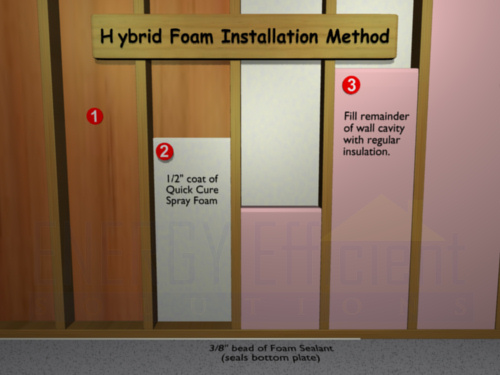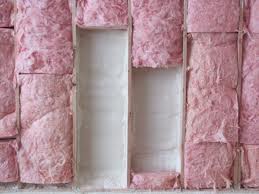Flash-and-Batt Insulation

Flash-and-Batt Insulation
For any home, air sealing is critical. A well-insulated structure reduces energy usage (and costs) and makes the interior living spaces more comfortable year-round. There are several ways to insulate a home; one newer technique is referred to as flash-and-batt insulation, also known as hybrid foam insulation.
What Is It?
Flash-and-Batt insulation, or hybrid foam insulation, combines the best qualities of two types of home insulation into one effective and affordable option.
Spray-foam insulation is one of the most high-performing forms of home insulation. Sprayed into wall cavities , attic spaces, and roofs, it expands and hardens, forming a complete airtight barrier. Air leakage is virtually eliminated, and spray foam's high R-value (between 3.6 and 6.8 per inch) greatly reduces a home's heating and cooling costs. Spray foam insulation's main drawback? While extremely effective, it's also among the most expensive forms of insulation.
Batt-type insulation is the most well-known and commonly-used insulations. Primarily made from fiberglass, mineral wool, or other natural or artificial fibers,the familiar looking rolls of insulation is installed by fitting the blanket between wall studs, joists, and beams. While it's an ideal insulation for do-it-yourselfers, and in standard stud or joist spacings that are relatively free of obstructions, improper installation can leave gaps between the insulation and the studs or joists, allowing for air and moisture infiltration into the living space.
Batt insulation is more often used primarily due to its lower upfront costs. It's much cheaper than spray-foam insulation, though it may be less effective.
Flash-and-Batt Insulation - The Best of Both Worlds:
Contractors have found that, by combining these two types of insulation, a high level of insulation performance can be achieved at a cost that's often much lower than using spray foam alone.

Flash-and-batt insulation is installed by spraying a relatively thin layer (1/2 to 2 inches) of high-density polyurethane foam onto the homes' interior sheathing. Then, batt insulation rolls (or sometimes loose fill insulation) is installed over it.
Flash-and-Batt Insulation creates a thermal barrier that has a slightly higher R-value than if only batt insulation were used. This is because the foam insulation, in addition to adding R-value, will eliminate the cracks and gaps that often plague batt insulation installations.
How much spray foam insulation is used depends on the climate zone of the home; colder areas require thicker foam installation to keep the wall or attic cavity above the dew point level during the winter.
Pros and Cons of Flash-and-Batt Insulation
As noted, flash-and-batt insulation typically performs better than batts only, at a price point that's lower than using spray foam exclusively. Like anything associated with home construction, there are advantages and disadvantages to using this technique. First, let's examine the advantages of flash-and-batt.
The Pros:
- Higher R-Value. As mentioned, a flash-and-batt wall will have a higher R-value than batts. If you replace 2 inches of batt insulation (R-value of 3.5 per inch) with the same amount of closed-cell spray foam insulation(R-value of 6 per inch), that wall (attic, roof, etc.) will provide a higher level of thermal resistance.
- Reduced Air Leakage: Batt insulation has the aforementioned issues with air leaks through gaps and cracks. Also, fiberglass or cellulose is air permeable and must have an air barrier installed to avoid this (such as a structural wrap like Tyvek. In a flash-and-batt installation, the spray foam insulation is the air barrier.
- Ease of Installation: Flash-and-batt requires no special construction; contractors can use standard house framing which further keeps cost in check when compared to other high-performance insulation installations such as SIPs.
- Moisture Control: The spray foam insulation keeps moisture out of the wall cavity. In colder areas, the required 2 inches of foam will keep the interior wall temperature above the dew point. It's important not to include an additional plastic vapor barrier on the wall's interior, as it will seal in moisture and limit the insulation's ability to dry out if it were to become wet or damp. This can lead to mold contamination.
The Cons:
- Cost: Installing a flash-and-batt system has the same cost as a traditional batt-only installation with the added expense of the spray foam insulation. The benefits are greater, but it's important to realize that there are higher construction costs involved.
- Thermal Bridging: Flash-and-batt insulation doesn't address the issue of thermal bridging through the home's uninsulated wood studs, since these studs will still be exposed as they are in a traditional batt-only installation.
- Environmental Factors: There is debate in the green home movement over the use of spray foam insulations. Though they excel at saving energy in the home, they require a large amount of energy to manufacture. Most spray foam insulations are made with petroleum based products and propellants that many wish to avoid. The decision to use spray foam is a personal one based on its performance, cost, and environmental benefits and drawbacks.
comments powered by Disqus

























































































































































































